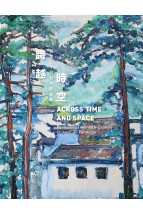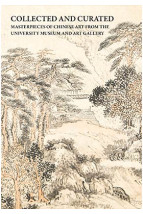Reflected Beauty 鏡花薈萃
Chinese Reverse Glass Paintings from the Mei Lin Collection 梅林珍藏的中國玻璃畫
ISBN : 978-988-74707-4-8
Distributed for HKU Museum and Art Gallery 香港大學美術博物館
March 2022
196 pages, 8.25″ x 10.625″, 92 color illus.
- HK$200.00
Reverse paintings on glass occupy a special place in Chinese art, spanning the genres of glass working, export art, folk art, erotica, and meiren hua (paintings of beauties). Their unique appearance is the result of a challenging production process in which artists layer pigments in the reverse order of the normal painting procedure–highlights first, then mid-layers, and finally base colours. The final product is viewed in reverse from the opposite side of the glass, which must also be considered when creating the paintings.
A product of the encounter between East and West, the manufacture of glass paintings in China was stimulated by European glass paintings brought to the imperial court by traders and diplomats in the seventeenth century. Initially made in Canton for Western consumers, by the eighteenth century their production had spread throughout China, with subjects and styles adapted to suit local tastes.
The glass paintings in the Mei Lin Collection represent this later flowering of works for the domestic market. Largely ignored by scholars and collectors in favour of exoticized paintings for the West, they depict romantic landscapes, traditional motifs of happiness, scenes from plays and novels, and the changing image of the Chinese woman, demonstrating the diverse appeal of this unique and fragile art form.
The reverse glass paintings presented in this publication and its accompanying exhibition are all from the Mei Lin Collection. Composed of over one hundred works acquired in East Asia between 1968 and 2012, it is one of the world’s most important collections of Chinese reverse glass paintings from the late nineteenth and twentieth centuries. The collection was assembled by Mr. Rupprecht Mayer and his wife Ms Liem Haitang. Parts of the collection have been shown in the City Museum of Augsburg, Germany, and in the Swiss Glass Museum in Romont, Switzerland.
呈現在玻璃上的反向繪畫在中國藝術中佔有特殊的地位,涵蓋了玻璃加工、出口藝術、民間藝術、色情藝術和美人畫等類別。它們獨特的外觀源自充滿挑戰性的生產過程。在該過程中,畫家必須顛倒正常繪畫的順序,以表裏倒序的步驟一層層上色:首先勾勒重點表層,然後畫出中層,最後才填上背景。觀者將會從玻璃的另一面觀賞製作成果,這一點是畫家作畫時必須考慮的要素。
十七世紀的商人和外交官向中國宮廷引入歐洲玻璃畫,為中國玻璃畫的製作帶來了契機,使其成為了象徵東西方相遇的產物。玻璃畫最初是在廣州生產,消費對象為西方的顧客群,但到了十八世紀,當地生產的玻璃畫已經遍跡整個中國,其主題和風格也隨之出現變化來迎合本土的品味。
梅林收藏中的作品代表了玻璃畫後來在國內市場的蓬勃發展。它們被只一昧地關注為滿足外國客人的「異國風情」外銷畫的學者和收藏家所忽略。玻璃畫主要描繪浪漫的風景、寓意萬福吉祥的傳統圖案、戲劇和小說中的場景以及中國女性形象的轉變,充份展現了這種獨特而精緻脆弱的藝術品賦有的多樣魅力。
於本書收錄及其相關展覽展出的玻璃畫全選自梅林收藏。它是由在1968年至2012年間在東亞地區搜求羅致的一百多件作品組成,以來自十九世紀後期和二十世紀的中國玻璃畫來說,是世界上最首屈一指的收藏之一。該收藏是由梅儒佩先生與其夫人林海棠建立而成。部分收藏曾於德國奧格斯堡城市博物館和瑞士羅蒙的瑞士玻璃博物館中展出。
梅儒佩,漢學家、翻譯家和畫廊經營者,在德國南部生活和工作。



